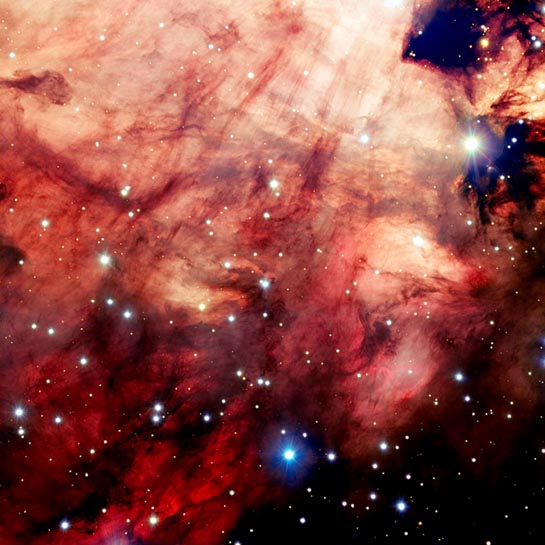
Star Formation Nebula
RA 18hr 20m 47s Dec -16 10.3
Sagittarius
6500 light years
ESO
January 4, 2012
More Images: N1119 N1044 N0030 N0211g N0925 N0313 N1201 N0211c
N1537
ABOUT THIS IMAGE:
A new image of the Omega Nebula, captured by ESO's Very Large Telescope (VLT), is one of the sharpest of this object ever taken from the ground. It shows the dusty, rose-colored central parts of this famous stellar nursery and reveals extraordinary detail in the cosmic landscape of gas clouds, dust and newborn stars.
The colorful gas and dark dust in the Omega Nebula serve as the raw materials for creating the next generation of stars. In this particular section of the nebula, the newest stars on the scene — dazzlingly bright and shining blue-white — light up the whole ensemble. The nebula's smoky-looking ribbons of dust stand in silhouette against the glowing gas. The dominant reddish colors of this portion of the cloud-like expanse, arise from hydrogen gas, glowing under the influence of the intense ultraviolet rays from the hot young stars.
The Omega Nebula goes by many names, depending on who observed it when and what they thought they saw. These other titles include the Swan Nebula, the Horseshoe Nebula and even the Lobster Nebula. The object has also been catalogued as Messier 17 (M17) and NGC 6618. The nebula is located about 6500 light-years away in the constellation of Sagittarius (The Archer). A popular target of astronomers, this illuminated gas and dust field ranks as one of the youngest and most active stellar nurseries for massive stars in the Milky Way.
The image was taken with the FORS (FOcal Reducer and Spectrograph) instrument on Antu, one of the four Unit Telescopes of the VLT. In addition to the huge telescope, exceptionally steady air during the observations, despite some clouds, also helped make the crispness of this image possible [1]. As a result this new picture is among the sharpest of this part of the Omega Nebula ever taken from the ground.
This
image is one of the first to have been produced as part of the ESO Cosmic
Gems programme
.
Notes:
[1] The "seeing" — a term astronomers use to measure the distorting effects of Earth's atmosphere — on the night of the observations was very good. A common measure for seeing is the apparent diameter of a star when seen through a telescope. In this case, the measure of seeing was an extremely favourable 0.45 arcseconds meaning little blurring and twinkling of the object of interest.